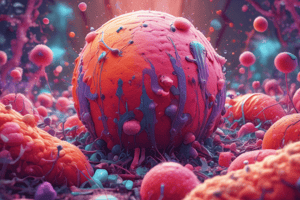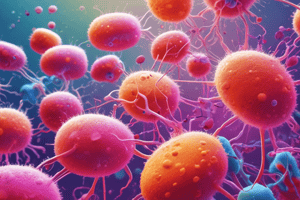Podcast
Questions and Answers
What is the minimum recommended treatment for reprocessing medical devices that cannot be sterilized?
What is the minimum recommended treatment for reprocessing medical devices that cannot be sterilized?
What is the purpose of drying medical devices after reprocessing?
What is the purpose of drying medical devices after reprocessing?
What is the recommended approach for drying medical devices when a drying cabinet is not available?
What is the recommended approach for drying medical devices when a drying cabinet is not available?
What is the minimum recommended treatment for reprocessing non-invasive medical devices for use in non-critical sites?
What is the minimum recommended treatment for reprocessing non-invasive medical devices for use in non-critical sites?
Signup and view all the answers
What is the main agent that affects the cleaning of used surgical devices prior to sterilization?
What is the main agent that affects the cleaning of used surgical devices prior to sterilization?
Signup and view all the answers
What is the recommended approach for drying medical devices to avoid exceeding the temperature tolerances advised by the manufacturer?
What is the recommended approach for drying medical devices to avoid exceeding the temperature tolerances advised by the manufacturer?
Signup and view all the answers
What type of disinfection is achieved in a thermal washer-disinfector?
What type of disinfection is achieved in a thermal washer-disinfector?
Signup and view all the answers
Which factor does NOT affect the effectiveness of chemical disinfection?
Which factor does NOT affect the effectiveness of chemical disinfection?
Signup and view all the answers
What is the main disinfectant of choice in endoscopy units?
What is the main disinfectant of choice in endoscopy units?
Signup and view all the answers
What defines the concentration, contact time, and minimum/maximum temperatures for adequate chemical disinfection processes?
What defines the concentration, contact time, and minimum/maximum temperatures for adequate chemical disinfection processes?
Signup and view all the answers
Which type of micro-organisms are not eliminated by disinfection?
Which type of micro-organisms are not eliminated by disinfection?
Signup and view all the answers
What does the level of disinfection achieved depend on?
What does the level of disinfection achieved depend on?
Signup and view all the answers
Why is the quality of water critical in the cleaning process of medical devices?
Why is the quality of water critical in the cleaning process of medical devices?
Signup and view all the answers
What action should be taken if exposed to a hazardous substance according to the Safety Data Sheets (SDS)?
What action should be taken if exposed to a hazardous substance according to the Safety Data Sheets (SDS)?
Signup and view all the answers
Why is it important to store chemicals below shoulder height?
Why is it important to store chemicals below shoulder height?
Signup and view all the answers
What can adverse water compositions during reprocessing potentially affect?
What can adverse water compositions during reprocessing potentially affect?
Signup and view all the answers
What is a key precaution when handling chemicals during medical device reprocessing?
What is a key precaution when handling chemicals during medical device reprocessing?
Signup and view all the answers
What is one of the hazardous properties associated with chemicals like detergents and disinfectants?
What is one of the hazardous properties associated with chemicals like detergents and disinfectants?
Signup and view all the answers
According to the Association for the Advancement of Medical Instrumentation (AAMI), what is one of the characteristics of process chemicals?
According to the Association for the Advancement of Medical Instrumentation (AAMI), what is one of the characteristics of process chemicals?
Signup and view all the answers
What should be considered when choosing process chemicals?
What should be considered when choosing process chemicals?
Signup and view all the answers
Why should defined, written procedures be used for handling and storage of process chemicals?
Why should defined, written procedures be used for handling and storage of process chemicals?
Signup and view all the answers
What should be done to control process chemicals?
What should be done to control process chemicals?
Signup and view all the answers
Why is it important to choose the least hazardous chemical that fulfills the process requirement?
Why is it important to choose the least hazardous chemical that fulfills the process requirement?
Signup and view all the answers
What is the primary factor to consider when determining the compatibility of water quality during the cleaning process?
What is the primary factor to consider when determining the compatibility of water quality during the cleaning process?
Signup and view all the answers
Which of the following is NOT listed as a factor to consider for water quality during the cleaning process?
Which of the following is NOT listed as a factor to consider for water quality during the cleaning process?
Signup and view all the answers
What is the purpose of conducting daily, weekly, and quarterly tests on the washer-disinfector?
What is the purpose of conducting daily, weekly, and quarterly tests on the washer-disinfector?
Signup and view all the answers
Which of the following is NOT included in the daily tests for the washer-disinfector?
Which of the following is NOT included in the daily tests for the washer-disinfector?
Signup and view all the answers
What is the purpose of the weekly cleaning efficacy test?
What is the purpose of the weekly cleaning efficacy test?
Signup and view all the answers
Which of the following is NOT listed as a periodic test for the washer-disinfector?
Which of the following is NOT listed as a periodic test for the washer-disinfector?
Signup and view all the answers
Study Notes
Reprocessing Medical Devices
- High-level disinfection is the minimum treatment recommended for reprocessing medical devices that cannot be sterilized, used for semicritical sites or when there are specific concerns regarding contamination of surfaces.
- Low-level disinfection is the minimum treatment recommended for reprocessing non-invasive medical devices for use in non-critical sites.
Drying
- Drying minimizes rusting, staining, and reduces the risk of recontamination during inspection and assembly of RMDs.
- Residual moisture interferes with the sterilization process.
- Methods for drying include using a clean disposable lint-free, absorbent wipe or a drying cabinet.
Process Chemicals
- Thorough cleaning of used surgical devices prior to sterilization is critical, and the main agent that affects cleaning is the process chemical used in the wash area of the CSSD.
- Factors to consider when handling chemicals include:
- Storing chemicals below shoulder height
- Making Safety Data Sheets (SDS) and labels available to staff
- Training personnel who handle chemicals
- Reading and following precautions and instructions given on the SDS and label
Water Quality
- The quality of water used at all stages in the cleaning process is critical to the successful outcome of the process.
- Unfavorable water compositions can have an adverse effect on the reprocessing process and on the devices themselves.
- Purified water rinse is used in the cleaning process.
Disinfection
- There are two types of disinfection: thermal and chemical.
- Thermal disinfection can be achieved in a thermal washer-disinfector by choosing the appropriate cycle.
- Chemical disinfection depends on factors including the initial number of microbes present, temperature, pH, and concentration.
- Chemical disinfection can be achieved with a compatible RMD-grade disinfectant of the required level, used alone or with a chemical washer-disinfector.
- Validation of chemical disinfection processes is done microbiologically, defining the concentration, contact time, and minimum/maximum temperatures for adequate disinfection.
Safety Precautions
- Chemicals such as detergents and disinfectants may have hazardous properties, including being irritant, corrosive, or flammable.
- Things to think about when dealing with process chemicals include choice of process chemicals, controls required, safety data sheets, and labeling.
Choice of Process Chemicals
- Choose process chemicals that are compatible with:
- The medical device
- The decontamination equipment to be used and the intended use of the device
- Choose the least hazardous chemical that will fulfill the process requirement.
Control of Process Chemicals
- Use defined, written procedures and methods for handling and storage of process chemicals.
- Clearly identify chemicals that should not be stored together.
- Consider factors such as pH, hardness, temperature, ionic contaminants, microbiological population, and bacterial endotoxins when using process chemicals.
Routine Testing of Decontamination Equipment
- Washer-disinfectors are subject to a schedule of periodic tests at daily, weekly, quarterly, and yearly intervals.
- These tests supply evidence that the washer-disinector is still operating within the limits established during commissioning.
- Tests include:
- Daily: Spray arm rotation, spray nozzles, removes and clean strainers and filters
- Weekly: Automatic control test, safety checks, water hardness, water conductivity, cleaning efficacy test
Studying That Suits You
Use AI to generate personalized quizzes and flashcards to suit your learning preferences.
Related Documents
Description
Learn about two types of disinfection methods: thermal and chemical. Explore how thermal disinfection can be achieved in a thermal washer-disinfector and the importance of monitoring the temperature to ensure effectiveness. Discover the benefits of both methods for decontamination.




